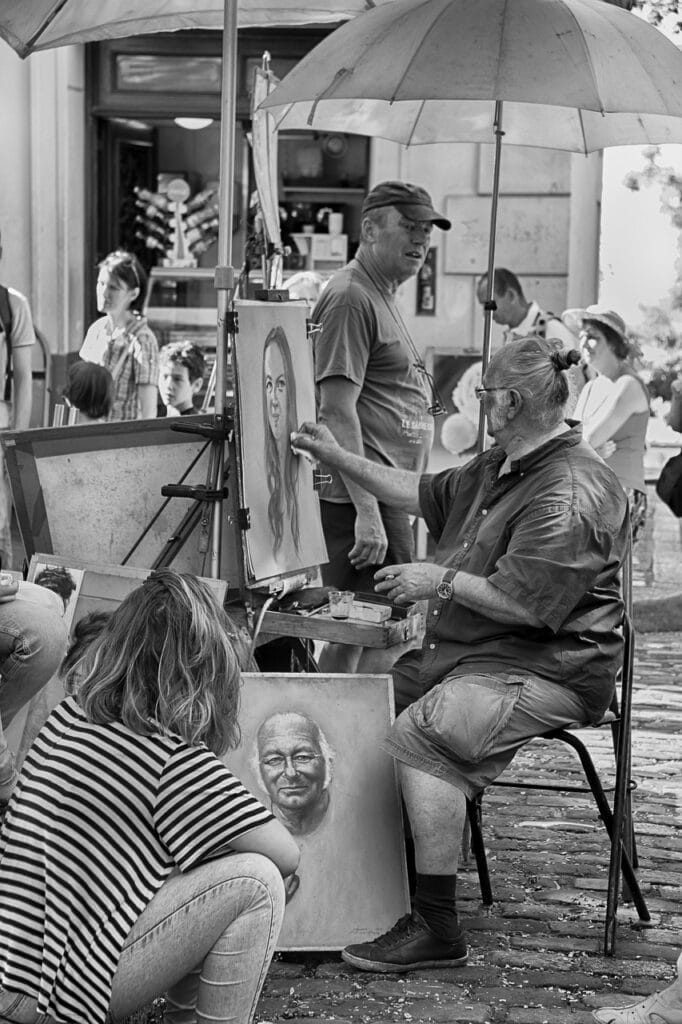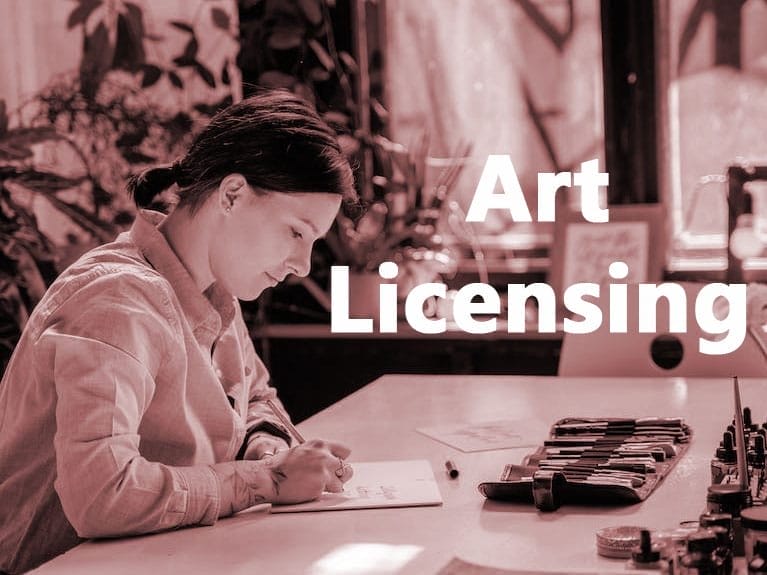Welcome to the world of art commissions! If you’ve ever wondered what it means when an artist says they’re “taking commissions,” you’re in the right place. Let’s break it down:

What are Art Commissions?
Art commissions are when someone pays an artist to create a specific piece of art just for them. Think of it like ordering a custom-made dress or suit. Instead of buying something off the rack, you’re getting something unique that fits your taste perfectly.
Types of Art Commissions:
- Portraits: Drawings or paintings of people or pets.
- Landscapes: Artwork of specific places or scenes.
- Custom Designs: Unique patterns or graphics for things like T-shirts or logos.
- Illustrations: Pictures for books, magazines, or websites.
| Key Takeaways and Recommendations |
|---|
| 1. Art commissions are a blend of business and creativity. |
| 2. They offer artists a chance to showcase skills, earn income, and build a client base. |
| 3. It’s essential to manage client expectations and set clear guidelines. |
| 4. Utilize social media, online communities, and dedicated platforms to find commission opportunities. |
| 5. Tools like online portfolios and payment platforms can streamline the commission process. |
| 6. Always communicate pricing and guidelines transparently to clients. |
| 7. Effective communication with clients ensures smooth project execution. |
| 8. Marketing strategies, like email campaigns and showcasing testimonials, boost credibility. |
| 9. Personal artistic pursuits are vital for growth and passion. Set aside time for them. |
| 10. Balance is key: prioritize self-care and personal development alongside commissions. |
Why Artists Should Take on Art Commissions
Taking on art commissions can be a transformative experience for artists. Beyond the evident financial benefits, commissions provide a platform to showcase versatility and adaptability in their craft. They open doors to a diverse range of projects, pushing artists out of their comfort zones and stimulating growth.
| Benefit | What It Means for You |
|---|---|
| Showcase Skills and Creativity | Let the world see and enjoy your art. |
| Earn Money | Turn your passion into profit. |
| Build a Loyal Fan Base | Grow your community of art lovers. |
| Artistic Growth | Take on new challenges and learn. |

One of the most rewarding aspects of taking on art commissions is the opportunity it provides to showcase your talent. Imagine the pride you’d feel knowing someone is wearing a t-shirt with your artwork or has chosen to hang your painting in a prominent spot in their home.
These commissions not only allow the world to see and appreciate your artistry but also offer a platform for you to make someone’s day special with your creations. Moreover, the feedback you receive can be a valuable tool, helping you understand what resonates with people and what aspects of your work they particularly love.
While passion for art is a driving force for many artists, there’s also a practical side to consider. Art commissions offer a way to monetize your skills. By producing commissioned pieces, you can get compensated for doing what you genuinely love.
This approach can transform a beloved hobby into a sustainable business venture. Plus, the earnings from commissions might allow you to invest back into your craft, be it enrolling in an advanced art class or purchasing that premium set of paints you’ve been dreaming of.

Creating art is a deeply personal endeavor, and sharing it with the world can be both exhilarating and nerve-wracking. The beauty of art commissions is that they can introduce you to individuals who resonate with your style and artistic vision.
Over time, as you complete more commissions, you’ll find that you’re not just gaining clients but also building a community of fans. These are people who appreciate your art, look forward to your new creations, and often become repeat customers, helping spread the word about your talents.
Every artist, no matter how experienced, has room for growth. Art commissions present a unique opportunity in this regard. Each new project brings its own set of challenges and requirements, pushing you out of your comfort zone. This can lead to the exploration of new techniques, an adaptation of different styles, or even the fusion of various art forms. Moreover, the stories and ideas brought to you by clients can serve as fresh sources of inspiration, fueling your creativity in ways you hadn’t imagined.
Tips for Getting Your First Art Commissions:
- Start Small: If you’re new to commissions, begin with smaller projects. This way, you can manage your time better and not feel overwhelmed.
- Show Your Work: Share your previous artwork online or with friends. It will help potential clients see your style and decide if it’s what they’re looking for.
- Be Open to Feedback: Listen to what your clients have to say. It will help you improve and deliver art that they’ll love.
Drawbacks of Art Commissions
While art commissions offer many exciting opportunities, they also come with their own set of challenges. But don’t worry! For every challenge, there’s a solution. Let’s explore some common drawbacks artists face when taking on commissions and ways to tackle them.
Creating art takes time, and when you’re working on commissions, there might be moments when you feel overwhelmed by the number of projects. It’s easy to lose track of time and end up working long hours. This can lead to burnout, where you feel too tired or stressed to create.
Solution:
- Plan Ahead: Use a calendar or planner to keep track of all your projects. This way, you can see which ones are due soon and which ones can wait a bit.
- Take Breaks: Remember to take short breaks during your workday. A quick walk or a cup of tea can help refresh your mind.
- Set Boundaries: It’s okay to say no to new projects if you feel you have too much on your plate. Your well-being comes first!
Every client has a vision for their commissioned piece. Sometimes, what they imagine and what you create might not match up. This can lead to requests for changes or revisions, which can be frustrating.
Solution:
- Clear Communication: Before starting a project, talk to your client about their expectations. Sketch out rough ideas to make sure you’re on the same page.
- Set Limits: Decide on a fixed number of revisions you’re willing to make. This way, both you and the client know what to expect.
- Stay Positive: Remember, feedback is a way to improve. Stay open-minded and view revisions as a learning experience.
Unlike a regular job, art commissions don’t guarantee a fixed paycheck every month. Some months might be great with lots of orders, while others might be slow.
Solution:
- Diversify Your Income: Don’t rely only on commissions. Consider selling prints, teaching art classes, or working on other projects to earn money.
- Save for Rainy Days: Put aside a portion of your earnings during good months. These savings can help during slower periods.
- Promote Your Work: Stay active on social media and art platforms. The more people see your work, the higher the chances of getting commissions.
Finding Art Commissions
So, you’ve decided to take the leap and start offering your skills for art commission work. That’s fantastic! But where do you begin? How do you find people who want to commission artwork? Let’s explore some steps to help you get started.
1. Social Media is Your Friend
Social media platforms are bustling hubs for art enthusiasts and potential clients. Platforms like Instagram, Facebook, Twitter, and even Discord servers dedicated to art can be goldmines. By consistently posting your work of art and engaging with other artists and art lovers on these platforms, you can create a dedicated following.

Discord servers, in particular, often have dedicated channels where artists can advertise their availability for commissions. Make sure to highlight in your bio or posts that you are available for commission. This visibility ensures that anyone who admires your artist’s work knows they can approach you for a commissioned work.
2. Join Online Artist Communities
The internet is home to numerous forums and communities where art enthusiasts often commission pieces. Websites like DeviantArt, ArtStation, Behance, and Artistree.io are platforms where artists can not only showcase their art pieces but also interact with potential clients and other artists.
Artistree.io, for instance, is a growing platform that offers a space for artists to display their portfolios and connect with clients. By actively participating in these communities, you can gain insights, receive feedback, and most importantly, let others know you’re open to taking commissions.
3. Collaborate with Other Artists or Businesses

Collaboration can open doors to new opportunities and audiences. Consider partnering with a specific artist whose style complements yours, or team up with local businesses. For instance, local coffee shops, bookstores, or boutiques might be interested in showcasing local talent.
By displaying your artist’s work in such venues, you not only gain exposure but also tap into a clientele that appreciates art. Some businesses might even promote your work, letting their customers know that the displayed pieces are available for commission.
4. Dedicated Commission Platforms
Apart from general art platforms, there are specialized websites aimed at connecting artists with those looking to commission artwork. These platforms, like Artistree.io, allow artists to set up profiles, display their portfolios, and specify their commission preferences.
Potential clients can browse, compare, and choose artists based on their needs. It’s a streamlined approach, much like an online art gallery dedicated solely to commissioned art pieces.
Top platforms for commissioning art include ArtCorgi, Sketchmob, Commiss.io, Artistree.io
5. Attend Local Art Galleries and Shows
Real-world interactions can be just as valuable as online ones. Local art shows, galleries, or craft fairs offer artists a platform to personally connect with art enthusiasts. By setting up a booth or participating in group exhibitions, you can directly engage with potential clients, answer their queries, and even demonstrate your art process. Such events also allow you to gauge real-time reactions to your work, helping you understand what resonates with the audience.
In your journey to find art commissions, patience and persistence are key. While it might take time to build a steady stream of clients, each step you take brings you closer to turning your passion into a thriving commissioned art venture. Keep showcasing, keep connecting, and most importantly, keep creating!
Tools and Services for Obtaining and Managing Art Commissions
To maximize efficiency and ensure a smooth commissioning experience, artists should consider integrating specific tools and services into their workflow.

A robust online portfolio is fundamental. Platforms like Format offer professionally designed portfolio websites that act as a digital gallery. Here, artists can showcase a diverse range of their works, from digital art to pop art, allowing potential clients to get a glimpse of their unique art style. An online presence not only displays an artist’s versatility but also makes it easier for them to get art commissions, as clients can easily find and contact them.
Managing multiple commissions simultaneously can be daunting. This is where commission management tools come into play. These tools, similar to Format’s Workflow, help artists organize requests, set deadlines, and keep track of payments. For instance, if an artist is working on a piece inspired by the history of art, reminders for research, sketching, and finalizing the artwork can be set, ensuring no detail is overlooked.
When it comes to financial transactions, security is paramount. Online payment platforms offer a safe and straightforward way for artists to price commissions art and for clients to pay for their requested pieces. Whether selling a small commission artwork or a large mural, these platforms ensure that transactions are both timely and secure.
Before embarking on any artistic project, it’s imperative to sign a contract. Contracts, like those available on various legal resource websites, outline the specifics of the commission. They detail everything from the chosen art style to payment terms, ensuring both the artist and client have clear expectations.
Dedicated platforms, such as art commission websites, are invaluable in connecting clients with artists. These platforms simplify the process of commissioning a work of art, allowing clients to hire an artist whose style aligns with their vision. Whether someone wishes to commission a digital portrait or a custom art piece inspired by pop art, these websites streamline the process.
Setting Up Commission Guidelines and Pricing

Art commissions have become a popular way for artists to earn income and for clients to obtain personalized works of art. Whether you’re an established artist or just starting out, it’s essential to set clear guidelines and pricing for your commissions. This ensures both you and your client have a clear understanding of the process and expectations.
Before you accept a commission, it’s essential to define what types of commissions you offer. For instance, you might commission a painting, a digital illustration, or a sculpture. By showcasing your previous work on your website and social media, potential clients can get an idea of your style and capabilities. For example, if you’re a digital artist, you might display various digital artworks, highlighting different techniques and themes you’re comfortable with.
Pricing is often a challenging aspect for many artists. How do you price your art? A good starting point is to consider the materials required, the time to work on the commission and your level of expertise. For instance, an established artist with a significant following might charge more than someone just starting out.
Remember, commissioning art is no longer just for the elite; many private individuals also commission artwork for their homes or as gifts. Thus, having a range of price points can cater to different budgets.
For example, if you’re creating an artwork that requires expensive materials or intricate details, the price might be higher than a simpler piece. If you’re unsure, researching what other artists charge for similar work can give you a ballpark figure.
Once a client shows interest in commissioning an artwork, it’s essential to establish clear communication. This means discussing the details of what they want, from the subject matter to the colors and style. For instance, if someone wants to commission a painting of their pet, they might provide photos and specific details about the pet’s personality, which you can then incorporate into the artwork.
Always have a contract in place before starting any commission. This contract should outline the specifics of the commission, the price, the expected completion date, and any other relevant details. For example, if you’re creating an art piece that will be displayed in public, the contract might specify where and how it will be displayed. The detail in the contract ensures both you and the client are on the same page and can prevent potential misunderstandings.
As you gain more experience and your art portfolio grows, you might find it necessary to adjust your commission guidelines and pricing. For instance, if you find that commissions often require more time than you initially estimated, you might need to increase your prices to reflect that. Or, if you notice a particular style or subject is in high demand, you might decide to focus more on that area.
Once the artwork is done, it’s essential to maintain contact with the artist. This doesn’t mean you need to chat every day, but sending updates on the commission’s progress, asking for feedback, or sharing photos of the artwork in its new home can build a lasting relationship. This can lead to repeat commissions and referrals.

Managing the Commission Process
Art commissions are special requests made by individuals or organizations who want artwork tailored to their preferences. Managing the commission process is essential for both the client and artist to ensure a smooth transaction and a satisfactory end product. Here’s how to effectively manage the process:
Communication is Key
- Establishing Effective Channels: Maintaining open and clear communication throughout the commissioning process is essential. Whether you’re a client looking to commission paintings or an artist accepting a project, make sure to have regular check-ins. For instance, if you’re a client and want to commission an artist, it’s a good idea to view examples of previous work in their art portfolio to ensure they’re the right artist for the type of work you have in mind.
- Setting Realistic Timelines: Artists usually have a good idea of how long it will take to complete the artwork. It’s essential to discuss due dates early on. For example, if you’re hiring artists for public art, they might need more time than for a smaller project.
Contracts and Agreements
- Why Sign a Contract: It’s always a good idea to sign a commission contract. This document will outline the expectations of both parties. For instance, if you want to commission public art, the contract might detail the size, location, and maintenance of the piece.
- What’s in the Contract: A commission contract should detail the type of work, payment terms, and any other specific requirements. For instance, some artists require a down payment before they start, while others might get a small commission upfront and the rest upon completion.
Managing Expectations and Revisions
- Understanding the Art: Art is the process of bringing imagination to life. If you’re a client, understand that sometimes the artist’s vision might differ slightly from yours. If you’re an artist, be open to feedback but also ensure that revisions are within reason.
- Revisions and Feedback: It’s common for clients to request changes. For example, if you commission an artist for a portrait and feel that the colors aren’t right, you can ask for adjustments. However, it’s essential to respect the artist’s time and expertise. Excessive revisions might require additional fees.
Professionalism Throughout
- Maintaining Reputation: Your reputation as an artist is vital. Always be professional, from the moment you accept commissions to the time you complete the artwork. If you’re a client, remember that artists put their heart and soul into their work. Treating them with respect can lead to a long-lasting professional relationship.
- Payment and Completion: Always ensure payments are made on time. If you’re an artist, deliver the artwork as promised. If you’re a client, pay as per the agreed terms. For instance, digital artists might send a watermarked version of the work until the final payment is made.
Seeking Help and Collaboration
- Working with Others: Sometimes, a project might be too big for one artist. In such cases, artists can also collaborate with other artists to help complete the project. For example, for a large public art mural, an artist might team up with another artist to finish it faster.
- Direct Contact: Always maintain direct contact with the artist. Whether you’re discussing ideas, revisions, or payments, direct communication ensures clarity. For instance, if you find an artist you love on a platform, try to contact the artist directly for commissions.
In summary, managing the art commission process requires clear communication, understanding, and professionalism from both the client and the artist.

Balancing Art Commissions with Personal Artistic Pursuits
Art commissions can be exciting and rewarding, but it’s essential not to lose sight of your personal artistic journey. Just like a musician needs to practice and play for fun, artists need time to create for themselves.
First, let’s talk about setting aside time for personal artistic development and experimentation. It’s important that artists have time to try new styles, techniques, or subjects to keep their creativity fresh. For example, if you always paint landscapes for clients, try sketching portraits or abstract art in your free time. This not only keeps you excited about your work but also helps you learn and grow.
Next, self-care is super important. Just like a plant needs water and sunlight, artists need rest and inspiration. If you’re always working on commissions, you might start to feel tired or even stressed. It’s okay to take breaks. Go for a walk, visit a museum, or read a book. These activities can refresh your mind and give you new ideas for your art.
Lastly, personal projects help keep your passion alive. Think of them as your special art projects, just for you. Maybe you’ve always wanted to paint a mural on your bedroom wall or create a comic book about your pet cat. These projects are like a playground for your creativity. They remind you why you fell in love with art in the first place.
Remember, while art commissions are a great way to earn money and build your career, your personal artistic pursuits are the heart of your journey. By giving both the attention they deserve, you can enjoy a fulfilling and balanced artistic life.
Final Words

Embarking on the journey of art commissions is both rewarding and challenging. As you navigate this path, always remember the passion that ignited your artistic spirit.
While commissions offer a platform to showcase your talent and earn, it’s your personal artistic pursuits that nourish your soul. Stay true to yourself, embrace every learning opportunity, and cherish the balance between work and personal creativity. Here’s to a vibrant, fulfilling, and inspired artistic journey ahead!





